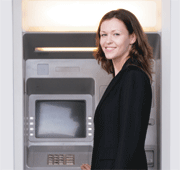Arizona State University chooses contactless technology from HID for campuswide functionality
02 July, 2004
category: Biometrics, Contactless, Corporate, Financial, Library
Arizona State University was looking for a “state-of-the-art” door access control system. Saddled with existing proximity and magnetic stripe cards, the university knew neither could handle more sophisticated security features such as biometrics. That was one of the reasons that led this large university to go with a contactless smart card produced by Irvine, California-based HID Corp.
ASU’s Sun Card program was started in the spring of 1997. The card is used for identification, library circulation control, registrar services, as well as access control to athletic and public events and the Student Recreation Center. The on-line debit card program, known as Sun Dollars, is used for making payments at merchants both on- and off-campus. Annual spending using the card has grown to $5 million.
“We are moving forward with a major security initiative that includes expanded door access control,” said the university’s campus card manager, Dale A. Witenhafer. “As part of this move, we wanted to have one central door access system that was state-of-the-art. The university had several systems in use and most of those (already) used proximity (125 MHz) technology, so mag stripe technology was not acceptable,” he added.
From there, the university considered expanding the proximity technology that was already in use on the campus. But, said Mr. Witenhafer, when the college’s IT department decided it “wanted the ability to store a digital certificate on the card, that meant we would need some storage capacity.”
Another strike against a prox card was security, said the ASU card manager. “We were concerned about the security of prox technology for some of our higher risk areas.”
But the deciding point that sealed the deal for contactless? “We had a good idea that biometrics were also going to play a part in our security plans,” said Mr. Witenhafer. “The ability to store a biometric template on the card was something we were interested in. When we put all of that together, contactless smart card technology seemed to fit the need the best.”
The contactless card selected by the university is the iCLASS card provided by HID. “We decided to go with the card with the most memory available – 16k – so the cards are not cheap,” said Mr. Witenhafer. But, it was determined to best fit current needs and enable the growth they would need.
At $7 a card, the university doesn’t plan on recarding the college’s 57,000 students and employees all at once. “We have issued 10,000 cards to date (since the first of the year),” he said. “All new students and employees get the new card. All replacements use the new card. Finally, anyone who needs a new card for door access can get the new card for free. So, as new buildings come on-line for door access, we are slowly transitioning from the old card to the new.”
Holly Sacks, HID’s vice president of marketing, said the new iCLASS cards at ASU “include a magnetic stripe to ensure seamless transition as mag stripe readers are replaced with iCLASS readers throughout the campus. ASU has ordered 40,000 cards with more phases planned for delivery later this year.”
She describes the new cards as “HID 13.56 MHz iCLASS 16k bit composite (PVC/Polyester), laminated cards with front and back, three-color printing.”
“ASU also elected to take part in HID’s Corporate 1000 Program that provides them with a unique 35-bit card format developed specifically for ASU and furnishes over one million-plus individual card numbers within the assigned format,” she added. “The assigned numbers are tracked during the manufacturing process to ensure that card numbers are never duplicated. These Corporate 1000 cards offer the students a single, universal card to use throughout the university’s campus and with any standard HID iCLASS card reader.”
Another benefit of iCLASS to ASU, said Ms. Sacks, “is that it offers the flexibility and security to integrate flawlessly into an access control system. If desired, ASU can use the system software to access or deny access on any door at any time. The iCLASS mutual authentication technology feature will insure the reader and card were programmed to communicate before the reader will send any signal to the panel. This same authentication will occur any time the iCLASS card is used for IT security, cashless vending in the cafeteria, or other on-campus applications.”
“The cards have been excellent,” said Mr. Witenhafer. “The technology is performing as good as, or better than, we imagined it would.”
While the card looks “like any traditional PVC card, it is slightly thicker (.033 instead of .030),” explained Mr. Witenhafer. “The front contains the pre-printed card design and is personalized with name, ID numbers, classification, and a photo. The back has a couple of logos, disclaimer language, and a 3-track hi-co magnetic stripe. The mag stripe is used for our debit account, meal plans, (both on-line) and off-line door access. The contactless chip and antennae are embedded in the card and are not visible unless you really know what you are looking for.”
The change-over has also been excellent, said Mr. Witenhafer. “Most (students) are not very aware of the additional functionality of the new card at this point. We changed the card design. Since we are not doing a mass re-carding, it has been a smooth transition.”
The real beauty of iCLASS will start to shine when the college starts implementing the building access program that led to the contactless conversion in the first place.
“We expect to start using the card to store biometric templates by September,” said Mr. Witenhafer. “We expect within the next 1 to 2 years to use the card to store digital certificates.”
Added Ms. Sacks: “Biometric readers, such as our bioCLASS reader, will be used in the future for areas such as ASU’s bio-labs and other areas for enhanced security. It is anticipated this program will be implemented within one year.”
Other future applications for the iCLASS card, she said, would include “cashless vending, logical access, and a few other custom applications.”
Though ASU is a high profile and major implementation, it is not the first campus to make use of the iCLASS contactless technology. “iCLASS is currently being deployed in several university campuses in the U.S. and other schools worldwide,” said Ms. Sacks. “The interest level remains high on many more campuses as well. iCLASS presents an exciting opportunity for universities to migrate to smart card technology for access control and add new applications for their student and staff cards while maintaining investments in existing infrastructures.”



